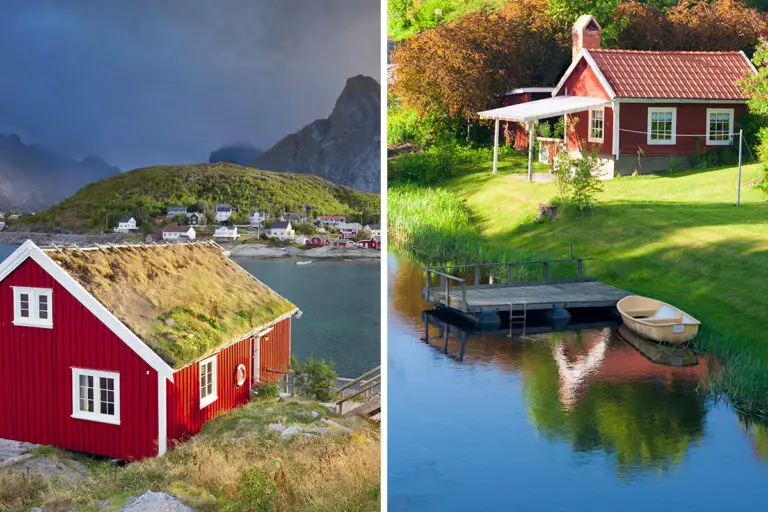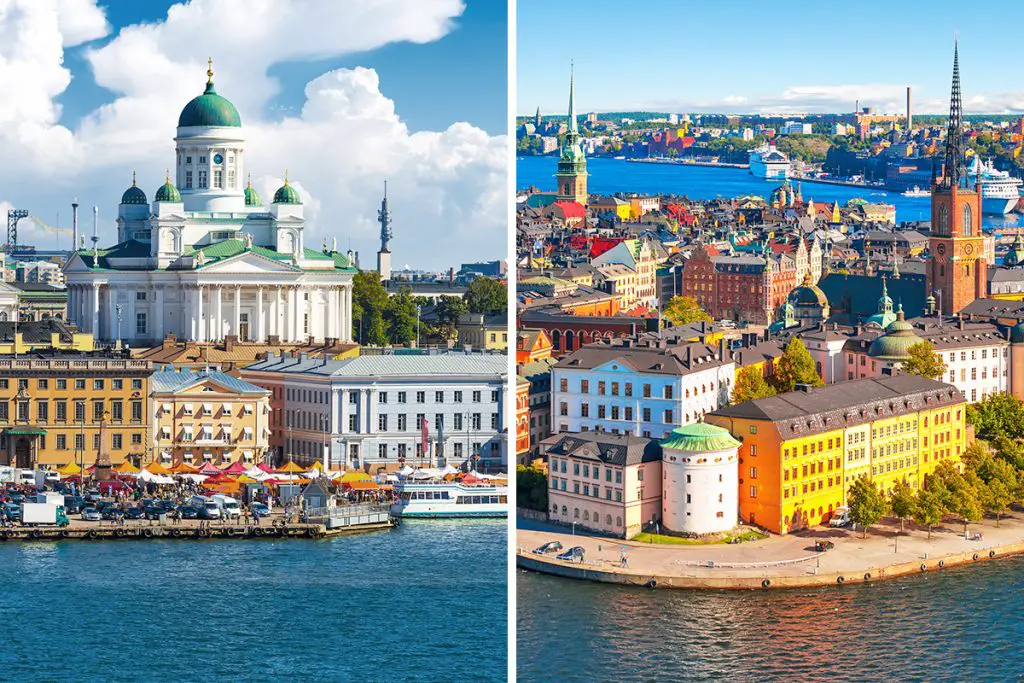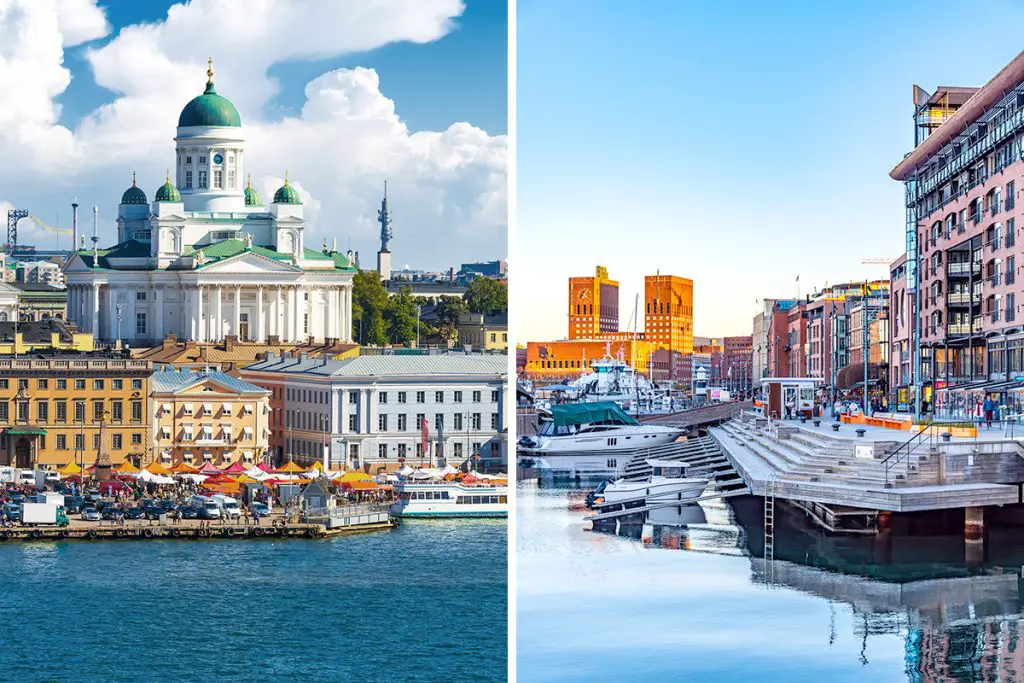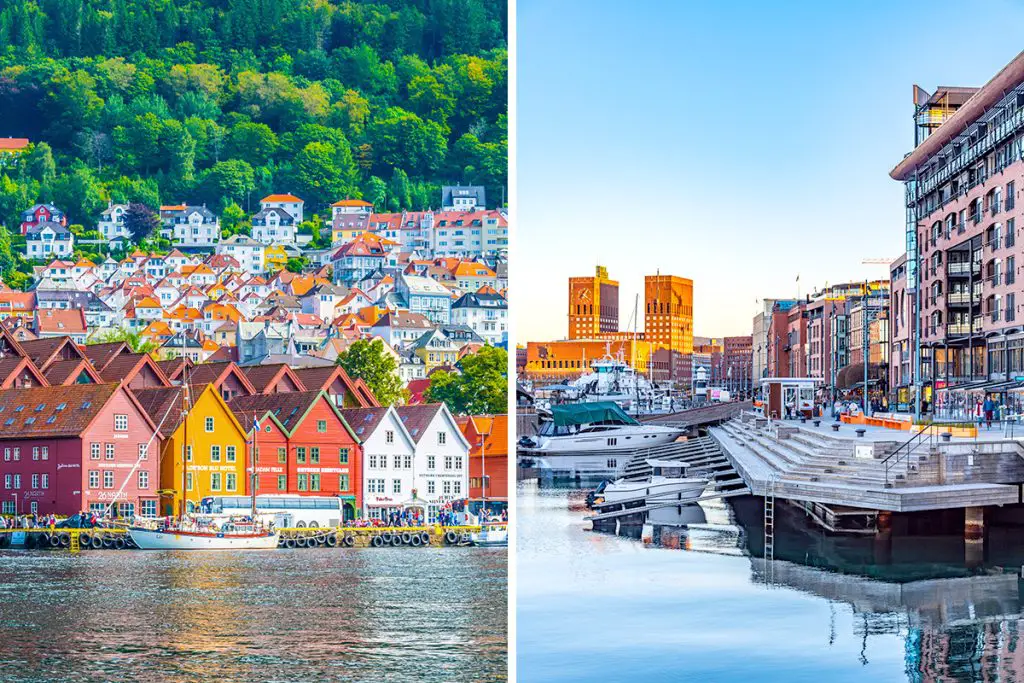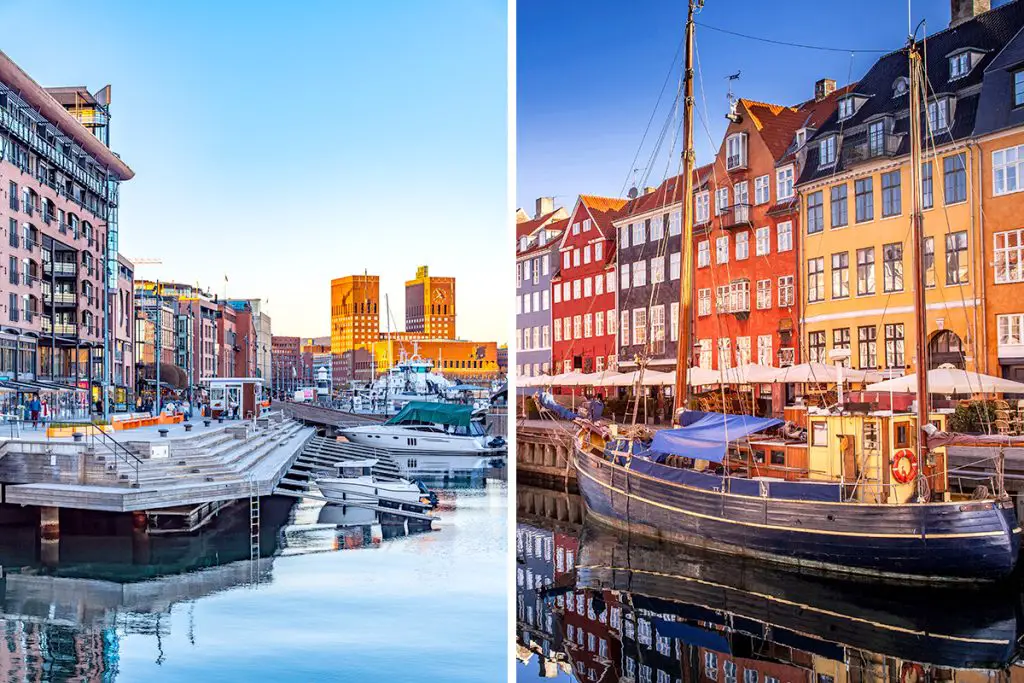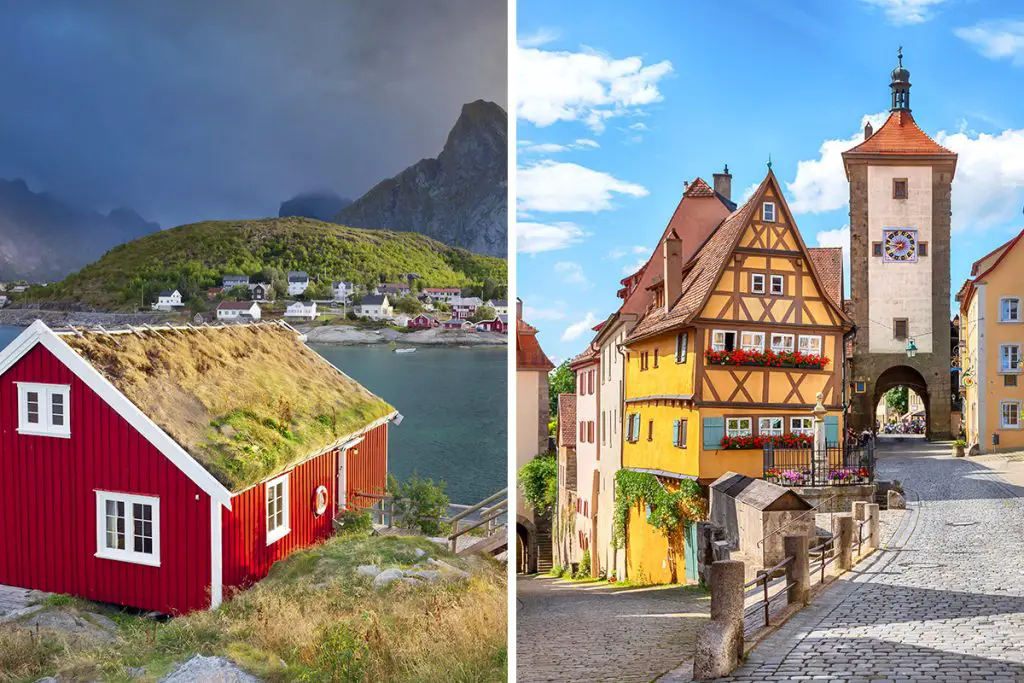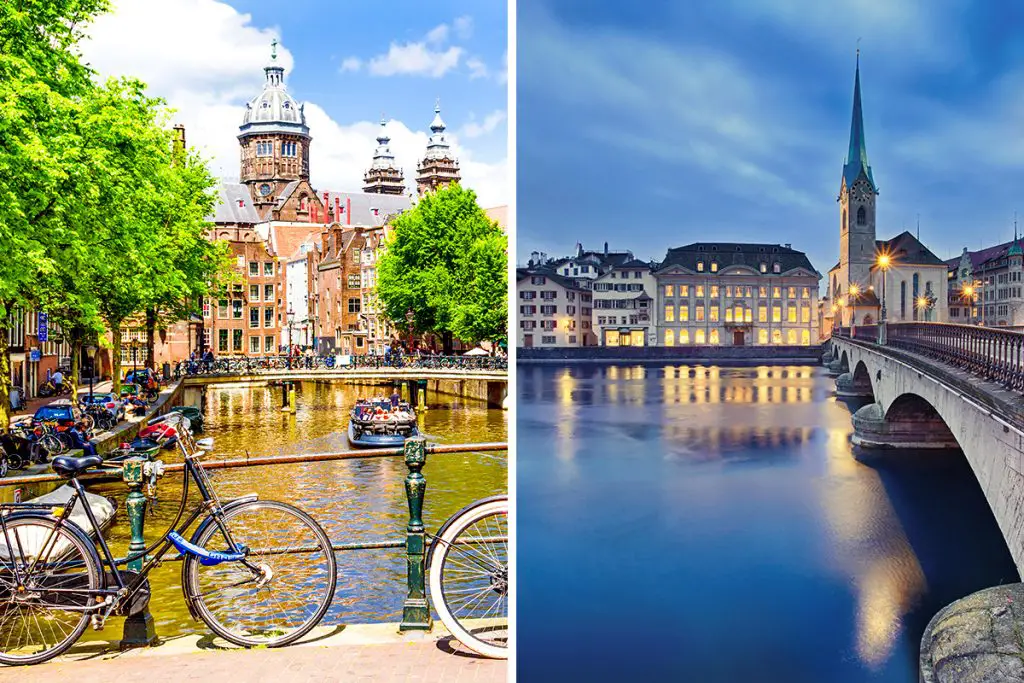Choosing between Norway or Sweden calls for some pretty hard decisions.
However, there’s an easy way to compare the two. For starters, Norway has over 1,700 fjords while Sweden has over 100,000 lakes.
Exploring fjords can be done in several ways. But the two most common are paddling along the deep blue waters or hiking to a mountaintop and getting a breathtaking view.
Because Sweden is so full of lakes and archipelagos, it’s safe to say kayaking is life in the country. A gentle paddle along Sweden’s lakes and lakeside camping are some of the best activities you can do.
Cabin life is pretty common in both Norway and Sweden too. But in terms of number, Sweden offers more waterfront choices, lakes, and archipelagos for a truly laid-back experience.
For outdoor junkies, Norway takes all. Glacier skiing, ice climbing, white water rafting, you name it.
All that said, there’s still more to learn about what Norway and Sweden have to offer. By the end of this guide, making a choice between the two should be easy.
Norway
Norway capitalizes on breathtaking and spectacularly beautiful scenery. The country’s fjords have become somewhat of an icon in the digital world.
Look to social media channels like Instagram, TikTok, or Facebook. Spotting photos of fjords under the tag “scenery” or “beautiful” is a common find.
However, fjords have seemed to overshadow the rest of Norway’s nature, beauty, and sights. Although a lot might talk about visiting Norway for its fjords, there are plenty of reasons to go aside from that.
Take Norway’s hiking opportunities as an example. Norway has more than a dozen hiking trails. Some are easy and beginner friendly, while others are truly for those seeking an adrenaline thrill.
A good example? Trolltunga.
Imagine being 700 meters (2300 ft) above a lake standing at a cliff’s edge with a space no wider than a queen-sized bed. The name “Trolltunga” also translates to “the troll’s tongue.” For any adrenaline junkie, Trolltunga is only one of the many outdoor experiences in Norway.
Adrenaline rush aside, Norway is also home to a ton of forests and national parks. In fact, you could say that Norway’s landscape, apart from fjords and coastlines, is full of green.
Want to see everything Norway has to offer? Take a scenic ferry ride or better yet, hop on a train and you’ll see nearly everything the country has to offer. This is also perfect if you’re short on time and want to maximize your sightseeing adventure.
The only downside is you won’t be able to spend a lot of time in each place.
If there’s one conclusion to draw from all that you’ve read, it’s this: Norway is worth visiting. Not just once, but several times. Why? Because it’s highly likely you’ll be able to see everything all in one visit.
Exploring the country’s fjords alone takes up a lot of time. But overall, Norway is a beautiful country that offers a mixed bag of nature, mountains, outdoor adventure, and relaxation.
What Makes Norway Unique?
A Wealth of Bucket List Attractions
Norway’s charm extends far past its fjords and majestic coastlines. Think colorful towns, scenic drives, snowy landscapes, and so much more.
It goes without saying that exploring the region of fjords is a bucket list attraction. Fjords like Geirangerfjord, Lysefjord, and Lofoten Islands are a few of the most spectacular worth visiting.
But there are several bucket list attractions also worth mentioning.
First, the Arctic Circle. The landscape alone is mystifying and mesmerizing. However, that’s not the only reason that makes it bucket list worthy.
Since most of Norway is situated in the Arctic Circle, this also makes it the best place for the Midnight Sun phenomenon. And of course, the Northern Lights as well.
Looking for a daring adventure that combines adrenaline with glaciers, rivers, and fjords? The Lyngen Alps counts as another bucket list attraction in Norway.
The Lyngen Alps is full of scenic gorges, beautiful mountain peaks, and a ton of space for an all-out snow safari. Skiing is a popular activity here, but if you truly want to push your limits, go rock climbing. The highest peak in the Lyngen Alps measures 1,833 meters (6,013.8 ft), so climb if you dare.
Moving past adrenaline-pumping attractions, there are more peaceful and scenic attractions to do as well. One of the most famous in the world, also known as The Troll’s Road, is Trollstigen.
This scenic drive is more like a semi-adventure. Because apart from the grand viewpoints and Stigfossen waterfall, there are also 11 hairpin turns. If that doesn’t appeal to you, there’s always the Atlantic Road, hailed as the most beautiful drive in the world.
In fact, the Atlantic Road was also voted as the “Norwegian construction of the century.” Once you’ve stretched your legs through Norway’s many scenic drive points, you can shift gears into kayaking mode.
Svalbard is yet again another bucket list attraction, famous for its glacier kayaking. Even better, you can also go on a sled dog expedition for three to four days or explore Svalbard’s landscape on a snowmobile.
To end this list of bucket list attractions in Norway, there’s always room for enjoying the view. The Lofoten Islands and the town of Bergen are fantastic places to escape, enjoy, and soak in waterfront views.
If you don’t mind putting in a little effort, you can also go hiking in Vesterålen. The summit’s peak at Vesterålen has a top-of-the-world experience you won’t want to miss while in Norway.
A Wealth of Daring Adventures and Extreme Outdoor Sports
Hiking is perhaps one of the most popular outdoor activities in all of Norway. But that’s only scratching the surface when it comes to the country’s list of daring adventures.
For the daring ones, hit up Folgefonna National Park for some serious glacier skiing. In addition, you can also do cross-country skiing and snowboarding in Folgefonna as well. Don’t worry, there are plenty of slopes here for beginners and newbies.
For the whole family and friends, Sjoa is the best place in Norway for white water rafting. Beginners and experienced rafters are more than welcome to test the waters in Sjoa. But if you want serious twists and turns, there’s a place that runs through the Aaseng Canyon in Sjoa perfect for that kind of thrill.
Aside from white water rafting in Sjoa, you can opt for canyoning which includes jumping in a cold mountain stream. There’s also zip-lining in Trolltunga that includes a trekking adventure and bike ride. For a boost of adrenaline, you can go paragliding in Voss, giving you views of the majestic Aurlandfjord.
If you’re still looking for more adventure, there’s ice climbing on frozen waterfalls in Lofoten Islands. Even better, Kjerag cliff is one of Norway’s prime base-jumping spots and definitely not for the fainthearted.
Norway Is Full of Relaxing Escapes
When was the last time you were able to truly get away from it all and recharge? With the never-ending list of things to do from answering emails to meeting deadlines, it’s hard to hit pause.
But in Norway, your opportunities to escape from all the stress and hustle are easily found. Starting with a huge list of accommodation options.
Why stay in a hotel when you can spend the night in Arctic domes? In cozy cabins high up in the mountains? Or even better, a sea cabin that sits above the ocean? In fact, glamping accommodations are available year-round.
Aside from Norway’s stellar accommodations, there are various ways to reconnect with nature. Hiking was one way, as mentioned previously. But if that doesn’t fit your outdoor style, you can opt for a scenic bike ride or go canoeing and kayaking along fjords.
Another fascinating option for exploring Norway is via train or boat. But of course, it’s not as simple as a half-day tour. You can go on a 3- or 4-day expedition via train or sightseeing ferry if you’re after a slow, relaxing journey.
The better question to ask is, how do you get to recharge in Norway? Because its landscape is so varied, finding a quiet place to spend in solitude is virtually available at every corner.
But if you’d rather stay close to Mother Nature from day 1, book a mountain cabin. Perched high up in the mountains, these cabins are the best choice if you want to disconnect from the world.
And don’t forget. You can also venture into Norway’s wilderness via its many signposted trails. For a long, easy hike, you can even walk a pilgrim path if you want to spiritually reconnect with yourself. Finally, places like Lyngenfjord and Tromsø and islands along the Helgeland coast are worth visiting too.
It’s One of the Safest and Easiest Countries to Travel In
Did you know Norway is one of the happiest places in the world? Even better, it has incredibly low crime rates so it’s safe to travel around and about. Of course, this isn’t to say you should be completely gullible and unaware of your surroundings.
It pays to stay vigilant no matter which part of the world you’re in. However, you can rest easier in Norway knowing that the country doesn’t have a high risk of crime-related activities.
Another reason why Norway is one of the easiest countries to travel in? No language barrier. Safe to say, almost everyone in Norway speaks English. It’s unlikely that you’ll run into a local that can’t speak English. What’s more, the locals are always happy to help.
Taking the train in Norway to explore different cities and regions is also easy to do. Speaking of exploration, Norwegians also have something called allemannsrett, which also means “freedom to roam.”
Essentially, this means you’re free to explore as much of Norway’s wilderness as you want. So much so that you can camp almost anywhere, including in uncultivated land. Want to pitch a tent on a mountain peak? You’re welcome to do so.
While you’re hiking along Norway’s landscapes, and if any catches your eye, feel free to camp the night. Of course, there are a few restrictions still. For instance, privately owned land isn’t possible.
Over 149,000 square miles (385,000 sq km) of Norway’s total land is unspoiled territory. That means your choices for camping and pitching tents just about anywhere are practically boundless.
Sweden
Sweden can easily be thought of as a nature lover’s dream. Over 60% of Sweden’s land is made up of forests.
Although Sweden is home to some stunning fjords, it’s not what the country is known for. The Stockholm archipelago, which is made up of over thousands of islands is Sweden’s prized jewel.
Thinking about island-hopping? Think bigger.
The Stockholm Archipelago is home to coves, secret passages, hiking trails, Viking history and so much more.
After all, Sweden isn’t one of the most visited countries in the EU for nothing. Something that may pique your interest is the country’s broad sauna opportunities. You’ll find a sauna just about anywhere in Sweden.
Hotels and swimming halls are a given. But did you know there are saunas perched in the middle of the forest? There are even several situated on the edge of the sea.
But that’s not all Sweden has to offer.
One of the most popular attractions and what you’ve most likely heard about is Stockholm Pride. It’s the largest Pride Festival in all of Scandinavia, with numbers reaching up to 600,000 total.
Speaking of festivals, Sweden is also popular for its Midsummer celebration and music festivals. On that note, music is a way of life in the country. And it’s quite evident seeing as how you have a lot of spots to choose from.
Altogether, Sweden features a gorgeous landscape, stunning islands, and fascinating culture. Interested to learn a few hidden gems of the country? The next section reveals them all.
What Makes Sweden Unique?
Breathtaking Natural Beauty
It’s no secret that the Swedes love nature. And similar to Norway, Sweden is home to some of the most marvelous nature sites.
While Sweden can’t compete with Norway in terms of fjords, it dominates with its lakes. And islands. Even national parks. There are over 100,000 lakes in Sweden. This also includes 30,000 islands and 29 national parks.
As a matter of fact, Sweden even has beaches! Some of the most pristine are found in the southern parts, along with the Stockholm Archipelago.
However, all this natural beauty you’re reading about now doesn’t compare to Sweden’s massive forestland. So massive it’s as if shades of green are an endless stretch throughout the country.
If you’re looking for the cream of the crop, start with Sarek National Park. The national park has an encompassing beauty that appeals to everyone and anyone. It’s also the oldest national park in the entirety of Europe.
If you’re looking for more nature to reconnect with, there are several parks you can explore. Some of these include Stora Sjofallet, Abisko, Skuleskogen, Muddus, and Fulifjallet.
Apart from national parks and expansive forests, Sweden is home to the Lapland region. Also known as the last wilderness of Europe, Lapland is a place you absolutely cannot miss. Lastly, don’t miss out on these beautiful lakes while you’re there:
- Lake Vänern
- Lake Vättern
- Lake Mälaren
- Lake Storsjön
- Lake Hjälmaren
Amazing Palaces, Royal Castles, and Beautiful Historical Landmarks
Sweden isn’t just a vast wilderness and natural beauty with rugged terrains.
It also comes with a charming side. Museums, castles, palaces, quaint towns, and even architecture.
You might’ve already heard about Stockholm Palace. Because after all, it’s arguably the most popular historical landmark in Sweden. However, this isn’t to say Stockholm Palace overshadows the rest of Sweden’s historical and cultural beauty.
Take King’s Garden or Kungsträdgården as an example. The garden is famous for its cherry blossoms that appear during spring. It’s even said that King’s Garden is a gift from Japan.
From here, you can choose to spend the rest of your day admiring Sweden’s grand castles. These castles are by no means old or rugged looking. The color, architecture, and crystal clear lake that surrounds it all add to its beautiful aesthetic.
Sweden is home to so many castles it’s hard to name each and every one. But there are a few worth mentioning, such as Läckö Castle.
Another noteworthy palace to visit is Drottningholm Palace. The royal palace has been a constant home for the Swedish Royal Family and is located on the island of Lovon. Getting here is easy, too, and easily accessible via boat.
You’ll also find a lot of boat tours that include a visit to the Drottningholm Palace. If you have extra time, it’s also worth exploring several regions and areas in Sweden. Some of these include:
- Norrland
- Oregrund
- Sundborn
- Gothenburg
- Oland Island
Unique Accommodations
If Norway has mountain cabins and rooms that sit above the sea, Sweden has ice hotels. Some accommodations are so quirky it’s worth spending the night at least once. And the Sala Silvermine Underground Hotel is perhaps one of the most unique you’ll ever find.
Because it’s literally an underground hotel that rests 155 meters below ground. Sweden’s famous ice hotel located in Jukkasjärvi is unlike anything else in the world.
Come winter, it’s freezing to stay in a cold room. But the good news is that there are also a ton of heated rooms too, which all come with subzero sleeping bags. You also have a lot of options for heated saunas in case it gets too cold.
But the real prize is being able to spend the night in a cold room. These rooms are kept between 17.6 to 23°F (-5 to -8 °C). Are you daring enough to spend 24 hours in a cold room?
Aside from underground and ice hotels, Sweden is also home to some of the most beautiful places to stay. You can opt for a glass house in the middle of a forest or a floating tent surrounded by pine trees.
There are also cozy forest retreat options, perfect for honeymooners looking for intimate accommodation. If you’re after a wanderlust experience, this would make for the perfect choice too.
Salt and Sill is also yet another unique accommodation, also known as Sweden’s first floating hotel. In fact, some even call it a boatel because all the rooms are situated above the water.
You can also stay at a cabin situated on a mountain pasture and go glamping at the beach or by a lake.
The Stockholm Archipelago
The Stockholm Archipelago is Sweden’s biggest attraction and hidden gem at the same time. Missing it is like going to Egypt and missing out on the pyramids.
In a few words, Stockholm Archipelago is a mix of great local cuisine, adventure, islands, and nature. But because it’s so vast, a lot of people don’t know where to start. And so, it depends on your schedule.
If you’re on a tight schedule, Vaxholm, Fjäderholmarna, and Gustavsberg are all excellent options. But if you have more time and are looking for excursions, Grinda, Nåttarö, Möja, and Utö are perfect. Other places to visit in the Stockholm Archipelago include:
- Blido
- Fejan
- Sandön
- Värmdö
- Finnham
- Roslagen
What is there to do in the Stockholm Archipelago? A ton.
For active travelers, you can go cycling, hiking, and kayaking. Svartso is known for its beautiful bike trails and is also one of the best places to go swimming. You can also visit many of the historic museums located on several islands. Camping is a popular activity and offers some of the most breathtaking sites.
And of course, don’t miss out on the local cuisine either. Vaxholm is home to a lot of local food options. A must-try is herring. For sweet tooths, Grinda offers the oh-so-famous Grinda bread and a local specialty: cinnamon buns.
Lastly, and for those in the mood to shop, Sandon has plenty of upmarket boutiques. This is only scratching the surface when it comes to the list of things you can do in the Stockholm Archipelago.
But rest assured, you’ll have a fantastic time exploring Sweden’s hidden gem attraction.
Is Norway or Sweden Better?
Both Norway and Sweden offer gorgeous scenery, outdoor adventure, and a ton of places to slow down and relax.
In fact, both are fantastic options for seeing the Northern Lights. And when it comes to accommodations or food, both countries excel without question.
But one of the biggest draws that separate Sweden from Norway is getting around.
Norway is so vast that it takes more time to get from one attraction to the other. Unless you have a specific itinerary in mind like visiting fjords and hiking solely. But if you’re after all of Norway’s beauty, you’ll need a lot of time and money to see them all.
Sweden, in comparison, offers travelers convenient public transportation. This means being able to see plenty of attractions in a short amount of time. But while Sweden is a lot easier to get around to see its many attractions, there’s one more factor to consider.
If you’re a hardcore outdoor enthusiast, Norway is the better choice. All the more if you love hiking and exploring.
For those in need of a relaxing vacation, either Norway or Sweden is an excellent choice. Although, you may be able to save slightly more in Sweden.
Needless to say, both are spectacular destinations worth visiting. Plus, both are some of the safest countries to travel as well.
FAQ
Sweden vs. Norway Economy
Sweden and Norway are some of the wealthiest countries in the world. This means both countries have great economies. However, the main difference between Norway and Sweden is in terms of GDP and GDP per capita.
Sweden’s GDP is higher than Norway’s, and arguably the country with the highest GDP as of this writing. That said, Norway has a higher GDP per capita, or the amount of money each individual gets.
What this translates to is Sweden has higher economic activity as a country. However, Norway’s higher GDP per capita reflects higher prosperity overall. In other words, the best way to measure GDP per capita is through living standards.
Is Norway Richer Than Sweden?
If you consider the GDP data and oil business of Norway, the country is richer than Sweden. And many will agree that Norway is indeed about 20% more prosperous than Sweden.
There are a few, though, that will say otherwise. Mainly in the industrial capital investment sector. In other words, Sweden’s plan for industrialization and sustainability is said to be much more advanced than Norway’s. As a result, some believe this asset makes Sweden richer.
This may also be a huge factor as to why Sweden’s GDP ranks as one of the highest in the world.
Norway vs. Sweden GDP?
Sweden’s GDP is much higher than Norway’s, with an annual GDP of around 541 billion in 2022. Norway, on the other hand, recorded a GDP of 362.5 billion. Over a 5-year term, Statista also records that the GDP growth rate of Sweden is around 2.7% while Norway’s is 1.7%.
Is Norway More Expensive or Cheaper Than Sweden?
Norway is more expensive to live in than Sweden. According to the site livingcost, Norway’s cost of living is 35% more expensive than Sweden’s. And even the consumer data from the site Numbeo also records Norway as the more expensive country.
To give you some insight, consumer prices in Norway are 28% higher than in Sweden. Groceries are about 30% higher as well in Norway than in Sweden.
Cost of living aside, Norway is also more expensive to visit than Sweden. Although there’s more to see and do in Norway, the travel distance between each place can easily add up to your total budget.
That being said, Sweden is also quite expensive even for tourists. For the most part, food and accommodation will be your biggest expenses if you visit either country. And should you plan on doing a lot of excursions, transport costs in Norway can be fairly substantial.
Do Norway and Sweden Use the Same Currency?
Norway and Sweden have different currencies, as does every Nordic country. The currency in Norway is the Norwegian Krone (NOK). Whereas in Sweden, the currency is the Swedish Krona (SEK).
Norway vs. Sweden Tourism
There’s no contest when it comes to tourism for both Norway and Sweden. Both are equally highly visited countries.
In fact, both rank high in regard to sustainable tourism. And the data reveals that both countries saw an annual tourist count of 5 million.
Norway or Sweden for Northern Lights?
Norway and Sweden are some of the best places to see the Northern Lights, along with Iceland and Finland. However, many will say Norway is the best place for seeing the Northern Lights if you want to catch one dancing over fjords and waterfalls.
But generally, any Nordic destination is a great choice. Mainly because Nordic countries like Sweden and Norway lie in the aurora zone.
The best time for seeing the Northern Lights is in November, December, and January. The downside though is that the weather can be brutal during these months. If you decide to visit during this time, this may warrant booking a tour so it’s easier to find the best place to spot one.
Safe to say, you can practically see the Northern Lights even from the city center in either country. And what matters in being able to catch a full glimpse of this spectacle is the time of day.
Typically, any time past 6 pm offers the highest chances possible. In Norway, the best places to see the Northern Lights lie in the northern area. Tromsø is by far the best place to go in Norway, along with the following:
- Svalbard
- Kirkenes
- Nordkapp
- Lofoten Islands
In Sweden, the best place for seeing the Northern Lights is in Abisko National Park located near Kiruna.
Is There a Border Between Sweden and Norway?
Technically, there is a national border between Sweden and Norway but is not considered a hard border. In other words, Norwegians and free to move from Norway to Sweden and vice versa.
You’ll spot a sign that says “Svergie.” If you follow the trail along this sign, it indicates you’re heading to Sweden. From Sweden to Norway, you’ll also spot the sign “Norge.” What this means is there are no strict borders that prevent one from visiting either country.
Geographically, Norway and Sweden are part of the Schengen Area. This also means there are no immigration controls when traveling between Norway and Sweden.
Sweden–Norway Border Snowmobile Trail
The Sweden–Norway border runs from Idefjorden located in Bohuslan to Treriksroset. This border spans a total of 1,010 miles (1,630 km). The only reason why it’s sometimes referred to as a snowmobile trail is it turns into a snowy route during winter.
Although the snowmobile trail is generally free to cross, there is one thing worth noting. And it’s that riding a snowmobile for fun is considered illegal in Norway. But in Sweden, it’s legal. This isn’t to say snowmobiling is completely illegal in Norway.
However, if you’re snowmobiling for recreational purposes, there are a few special trails that don’t allow doing so.
Norway–Sweden Border Shopping
Near the Norway–Sweden border is the Charlottenbergs Shopping Center. Because it’s so close to the Norway–Sweden border, a lot of people refer to it as cross-border shopping.
Its complete address is 1 Helga Goerlins Gata, Charlottenberg 673 32 Sweden. According to Google Maps, it’s along Kungsvagen road.
Is Norway and Sweden the Same?
Norway and Sweden are different in a lot of ways. Both are similar when it comes to unique landscapes and outdoor activities. But in terms of differences, there’s a lot to mention.
For starters, Sweden has the most efficient public transport system in the world. That shouldn’t come as a shock since Sweden is famous for its technologically advanced and innovative designs. However, Norway is several notches above Sweden in terms of environmental friendliness.
In fact, Norway’s capital, Oslo, is one of the greenest cities in the world. It’s no question that Norway has been constantly praised for its green spaces. This also includes its forests, parks, landscapes, and more.
Safe to say, Norway is the better choice when it comes to nature. That’s not all. Norway has a massive coastline and is home to a lot of great beaches.
Sweden, on the other hand, constantly ranks high for its culture, history, and fascinating cities and landmarks. After all, Sweden is also one of the most beautiful countries in the world.
These are just some of the differences to note between Sweden and Norway. So, you might also be wondering, are Sweden and Norway in the same league when it comes to natural beauty?
It depends. Because Norway’s fjords, green landscape, and outdoor wilderness are what makes the country so beautiful to visit. While in Sweden, its parks, cities, landmarks, and islands also give tourists a breathtaking scene.
Is Norway and Sweden in the EU?
Sweden is part of the European Union (EU) but Norway isn’t. Rather, is part of the European Economic Area (EEA) and European Free Trade Association (EFTA).
Is Norway in Sweden?
Norway is not in Sweden. Both are countries located geographically separate from one another. Based on the world map, it’s clear that Norway is not located in Sweden. Although both share a border, this doesn’t mean Norway is located in Sweden and Sweden in Norway.
Is Norway Near Sweden?
Norway is quite near to Sweden so much so that you can drive from one country to the other.
Norway to Sweden Distance
According to Google Maps, the distance between Norway and Sweden is about 473 miles (761.3 km) via car. The most popular route is Route E6 which stretches from Kirkenes, Norway, to Trelleborg, Sweden. It’s the most scenic route where you’ll be able to see a lot of fjords and mountains along the way.
Is Sweden Bigger Than Norway?
Among all the Nordic countries, Norway is the largest followed by Sweden. Norway’s area size amounts to approximately 241,313.8 square miles (625,000 square km). Whereas Sweden’s is 172,587.7 square miles (447,000 square km).
Despite having a larger area size, Norway’s population is less dense, having a total of about 5.5 million. While in Sweden, the total population is around 10.4 million.
Norway vs. Sweden Culture
Just as how Norway is different from Sweden in the scenery, both also have cultural differences. Taking a closer look at each country’s heritage alone already tell you that Norway and Sweden have a different culture.
For instance, did you know Norwegians have a British-Irish heritage? And for the Swedes, it’s typically a Finnish/Russian/Baltic heritage.
An obvious cultural difference between the two is language. Norway has two official languages: Sami and Norwegian. While in Sweden, their language is Swedish or Svenska.
Norwegians are also known to be more nationalistic while Swedes are more open-minded.
Even in a business setting, both are also different from each other. Norwegians are more individualistic and make quicker decisions. Whereas Swedes lean more towards planning and following through on those plans.
Another notable difference is that Norway has a stronger outdoor culture. While Sweden has a stronger indoor culture. Another way of looking at it is Norwegians are more outdoorsy or rugged whereas Swedes are more of homebodies.
A good way to describe this difference is how their Sundays would look like. In Norway, activities lean more towards a hike to the mountains or forest and having a cozy lunch there. This is also known as søndagstur. In Sweden, a typical Sunday is termed as fika, or coffee break.
Do Norway and Sweden Speak the Same Language?
Norway and Sweden speak different languages. The official language in Sweden is Swedish and Norwegian in Norway.
Was Norway Part of Sweden?
Norway used to be a part of Sweden. In fact, all of Scandinavia used to be united under a single crown. This was also known as the Kalmar Union and remained this way for at least a century.
Sweden eventually separated and it wasn’t till about 1814 that Norway became in union with Sweden. This union continued for another 100 years until Norway finally gained independence.
Why Did Sweden and Norway Split?
A lot of tension already existed between the two countries during the Napoleonic wars. However, it was when Norway didn’t have its own foreign service missions did it lead to the country fighting for its freedom.
Without having its own foreign service missions, this made it clear that Norway carried a lesser role in the union.
When Did Sweden and Norway Split?
Sweden and Norway split in 1905. Norway passed a law to establish it as a separate diplomatic service.
Do Norway and Sweden Get Along?
Norwegians and Swedes do get along, contrary to popular belief. It may not always seem the case considering their long history since 1397. Although there were a few feuds that arose during their union, any bitterness is long gone.
And if you ever hear Norwegians and Swedes bickering and bantering, it’s all in good humor and fun.
Are Norway and Sweden Socialist?
Norway and Sweden, along with other Nordic countries embraced socialism for a time. This happened between 1970 and 1990. Many believe though that Norway and Sweden still uphold socialist policies, this isn’t true.
Because as it currently stands, Norway and Sweden are centrist. While socialists are generally leftist in nature, centrists believe there are no left- and right-wing policies. Rather, centrists believe in policies that work best for a given place and time.
Some may still say that centrists are socialists, but at the same time, it’s also what people say about capitalists. However, it’s more accurate to say that in some ways, you can be a socialist. And in some ways, you can also be centrist.
But on a technical level, Norway and Sweden aren’t socialists.
Sweden to Norway
It’s easy to travel from Sweden to Norway and vice versa using several modes of transport. You can take the bus, train, ferry, or even a plane from Sweden to Norway. Traveling via plane will give you the quickest travel time, but taking the train is the most scenic and enjoyable.
Norway to Sweden Travel Time
The travel time from Norway to Sweden depends on the mode of transport you’re using. If you’re traveling via plane, it only takes one hour from Norway to Sweden. If you’re using a rental car, bus, or train, the average travel time is around five hours.
Lastly, if you’re taking the ferry, you’re looking at a total travel time of approximately 2 hours and 30 minutes.
Norway to Sweden Distance by Flight
The air travel distance from Norway to Sweden is 350 miles or 563 kilometers.
Sweden to Norway by Ferry
There are two ferry lines that service the ferry route from Sweden to Norway: Fjord Line and Color Line. The routes usually depart from Stromstad and arrive in Sandefjord.
It’s worth noting that Fjord Line offers two daily departures, and Color Line offers four daily departures. You can also book online for convenience.
Norway to Sweden by Train
Taking the train from Norway to Sweden is one of the most popular options for tourists. But not solely because it’s affordable. Taking the train also provides a scenic experience, being able to see the landscape of Scandinavia. This includes fjords, mountains, forests, lakes, and more.
On average, the travel time from Norway to Sweden takes about six hours. The usual route is from Sweden’s capital, Stockholm, to Norway’s capital, Oslo. You’ll also find several railway companies that offer the Norway–Sweden service.
There are three types of trains you can take from Norway to Sweden: SJ trains, NSB trains, and Flamsbana trains.
All three offer unique services. For instance, SJ trains are high-speed trains that offer services similar to what you’d find on an express route.
Flamsbana trains offer a scenic rail journey, and NSB trains offer regional and local train route services. NSB trains also come with sleeping compartments for overnight rides.
Norway to Sweden Train Cost
The cost from Norway to Sweden via train is 500 to 700 Norwegian Krone or NOK (USD 50.08 to 70.11 at 0.10 NOK a dollar).
How Far Is Norway From Sweden by Train?
The railway distance from Norway to Sweden is 259.1 miles (417 km). The fastest train travel time takes approximately 4 hours and 56 minutes. This is the case if you’re taking a high-speed train.
Sweden to Norway Train Duration
The fastest travel time from Sweden to Norway takes about 5 hours and 15 minutes. On average, the travel time takes roughly six hours.
Sweden to Norway Bus
Taking the bus from Sweden to Norway is the cheapest among all options, but also the longest. The average travel time is approximately 7 hours and 30 minutes.
The bus departs from the Stockholm terminal and arrives at the Oslo terminal. If you want to take the bus, note that there are 3 bus trips daily. Bus ticket prices range from 336.7 to 431.4 Swedish Krona or SEK (USD 32 to 41 at 0.095 SEK a dollar).
You can buy your tickets directly at the Stockholm terminal or online for convenience.
Norway to Sweden by Car
Norway to Sweden by car is a great option if you want a scenic drive and see beautiful landscapes along the way. The travel time takes between seven to nine hours. However, this also depends on how many stops you make along the way.
According to several travelers who have driven from Norway to Sweden, the journey can even take 12 hours. Of course, this also includes making stops along the way, taking pictures, grabbing some grub, etc.
Many also suggest taking the E6 North route to get the most out of your trip. There are a lot of highways and routes you can take from Norway to Sweden, so it shouldn’t be a hassle to drive at all. Not to mention, Google Maps also provide several routes for you to decide.
Best Way to See Norway and Sweden
Train travel is the best and most scenic way to experience Norway and Sweden. Because Norway and Sweden offer so much to do and see, it’s easy to splash most of your money on tours. This undoubtedly racks up costs, expenses, and your overall budget.
Also, you can save major attractions as organized tours. The Stockholm Archipelago in Sweden for example can be done either at your own pace or through a tour. However, it’s better to consider a tour since the Stockholm Archipelago has so much to see that you might feel clueless as to where to start.
Don’t also miss out on Sweden’s cities and cultural landmarks, like its castles, palaces, and more. These are some of the highlights of visiting Sweden, and one of the best ways to experience the country.
The best way to experience Norway? It depends on what you’re looking for.
Norway has more than enough for adventurists and solitude seekers. So if you’re after adventure, hiking, and mountains, there are tours that offer this kind of itinerary.
For those who are after an escape, there are tons of parks stretched throughout Norway worth seeing. Or, spend a little more for unique accommodations in Norway. This is in fact one of the best ways to see it after all. Think mountain cabins, sea cabins, and arctic domes.
Last but not least, the Arctic Circle is also one of the best ways to see and experience Norway.

